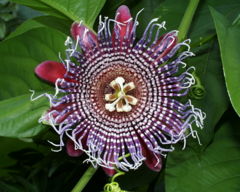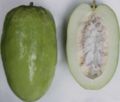Giant granadilla: Difference between revisions
No edit summary |
No edit summary |
||
| (One intermediate revision by the same user not shown) | |||
| Line 1: | Line 1: | ||
{{ | __NOTOC__{{Plantbox | ||
| | | name = ''Passiflora quadrangularis'' | ||
| | | common_names = Giant granadilla, Badea | ||
| image = | | growth_habit = vine | ||
| image_width = | | high = <!--- 1m (3 ft) --> | ||
| image_caption = | | wide = <!--- 65cm (25 inches) --> | ||
| regnum = | | origin = <!--- Mexico, S America, S Europe, garden, etc --> | ||
| divisio = | | poisonous = <!--- indicate parts of plants which are known/thought to be poisonous --> | ||
| classis = | | lifespan = perennial | ||
| ordo = | | exposure = full sun | ||
| familia = | | water = regular to moderate | ||
| genus = | | features = flowers | ||
| species = | | hardiness = <!--- frost sensitive, hardy, 5[[Celsius|°C]], etc --> | ||
| | | bloom = <!--- seasons which the plant blooms, if it is grown for its flowers --> | ||
| | | usda_zones = <!--- eg. 8-11 --> | ||
| sunset_zones = <!--- eg. 8, 9, 12-24, not available --> | |||
| color = IndianRed | |||
| image = Passiflora quadrangularis (1).jpg | |||
| image_width = 240px | |||
| image_caption = flower | |||
| regnum = Plantae | |||
| divisio = Magnoliophyta | |||
| classis = Magnoliopsida | |||
| ordo = Malpighiales | |||
| familia = Passifloraceae | |||
| genus = Passiflora | |||
| species = quadrangularis | |||
| subspecies = | |||
| cultivar = | |||
}} | }} | ||
{{Inc| | |||
Passiflora quadrangularis, Linn. Granadilla. Fig. 2770. Tall | |||
strong climber, glabrous: lvs. ovate or round-ovate,cordate at base, | |||
mu- cronate, entire, the petiole with 2 or 3 pairs of glands: | |||
stipules large: fl. large (3-5 in. across) and interesting, fragrant | |||
with ovate sepals and petals (the former white within and the latter | |||
reddish), the crown composed of 5 series of white-and-purple | |||
particolored filaments, of which the outermost exceed the floral | |||
envelopes: fr. oblong, 5-9 in. long, yellowish green, pulpy and | |||
edible. Trop. Amer. B.R. 14. R.H. 1898, p. 569. Gn. 51, p. 313; 59, | |||
pp. 4, 7. G. 33:161 — Widely grown in the tropics, and variable, both | |||
as a vine and for its edible frs. Frequent in collections of economic | |||
plants in the N. It is a good climber for covering a greenhouse roof. | |||
Best results are secured if the temperature does not fall below 50°. | |||
The fr. ripens in summer. The fls. usually need to be hand-pollinated | |||
if fr. is wanted on house-grown plants. Var. variegata, Hort. (P. | |||
variegata, Hort. P. aucubifolia, Hort.), has foliage blotched with | |||
yellow. | |||
}} | |||
''Passiflora quadrangularis'', is the largest of the passionfruits. | |||
:''More information about this species can be found on the [[Passiflora|genus page]].'' | |||
==Cultivation== | |||
{{monthbox | |||
| color = IndianRed | |||
| name = <!--- type name of plant just to the right of the equal sign on the left --> | |||
| jan = | |||
| feb = | |||
| mar = | |||
| apr = | |||
| may = | |||
| jun = | |||
| jul = | |||
| aug = | |||
| sep = | |||
| oct = | |||
| nov = | |||
| dec = | |||
| notes = | |||
}} | |||
{{edit-cult}}<!--- Type cultivation info below this line, then delete this entire line --> | |||
===Propagation=== | |||
{{edit-prop}}<!--- Type propagation info below this line, then delete this entire line --> | |||
===Pests and diseases=== | |||
{{edit-pests}}<!--- Type pest/disease info below this line, then delete this entire line --> | |||
==Cultivars== | |||
==Gallery== | |||
{{photo-sources}}<!-- remove this line if there are already 3 or more photos in the gallery --> | |||
<gallery> | |||
Image:Badea.jpg | |||
Image:Passiflora quadrangularis1644531062.jpg | |||
Image:Starr 071024-0405 Passiflora quadrangularis.jpg | |||
</gallery> | |||
==References== | ==References== | ||
*{{ | <!--- xxxxx *Flora: The Gardener's Bible, by Sean Hogan. Global Book Publishing, 2003. ISBN 0881925381 --> | ||
<!--- xxxxx *American Horticultural Society: A-Z Encyclopedia of Garden Plants, by Christopher Brickell, Judith D. Zuk. 1996. ISBN 0789419432 --> | |||
<!--- xxxxx *Sunset National Garden Book. Sunset Books, Inc., 1997. ISBN 0376038608 --> | |||
==External links== | |||
*{{wplink}} | |||
{{stub}} | |||
[[Category:Categorize]] | |||
<!-- in order to add all the proper categories, go to http://www.plants.am/wiki/Plant_Categories and copy/paste the contents of the page here, and then follow the easy instructions! --> | |||
Latest revision as of 05:48, 23 June 2009
Passiflora quadrangularis {{{latin_name}}}
|
Giant granadilla, Badea
| ||||||||||||||||||||||||||||||||||||||||
|---|---|---|---|---|---|---|---|---|---|---|---|---|---|---|---|---|---|---|---|---|---|---|---|---|---|---|---|---|---|---|---|---|---|---|---|---|---|---|---|---|---|

|
|
| |||||||||||||||||||||||||||||||||||||||
| |||||||||||||||||||||||||||||||||||||||||
| Standard Cyclopedia of Horticulture |
|---|
|
Passiflora quadrangularis, Linn. Granadilla. Fig. 2770. Tall strong climber, glabrous: lvs. ovate or round-ovate,cordate at base, mu- cronate, entire, the petiole with 2 or 3 pairs of glands: stipules large: fl. large (3-5 in. across) and interesting, fragrant with ovate sepals and petals (the former white within and the latter reddish), the crown composed of 5 series of white-and-purple particolored filaments, of which the outermost exceed the floral envelopes: fr. oblong, 5-9 in. long, yellowish green, pulpy and edible. Trop. Amer. B.R. 14. R.H. 1898, p. 569. Gn. 51, p. 313; 59, pp. 4, 7. G. 33:161 — Widely grown in the tropics, and variable, both as a vine and for its edible frs. Frequent in collections of economic plants in the N. It is a good climber for covering a greenhouse roof. Best results are secured if the temperature does not fall below 50°. The fr. ripens in summer. The fls. usually need to be hand-pollinated if fr. is wanted on house-grown plants. Var. variegata, Hort. (P. variegata, Hort. P. aucubifolia, Hort.), has foliage blotched with yellow.
|
Passiflora quadrangularis, is the largest of the passionfruits.
- More information about this species can be found on the genus page.
Cultivation
| calendar? | ||
|---|---|---|
| January: | ||
| February: | ||
| March: | ||
| April: | ||
| May: | ||
| June: | ||
| July: | ||
| August: | ||
| September: | ||
| October: | ||
| November: | ||
| December: | ||
| Notes: | ||
- Do you have cultivation info on this plant? Edit this section!
Propagation
- Do you have propagation info on this plant? Edit this section!
Pests and diseases
- Do you have pest and disease info on this plant? Edit this section!
Cultivars
Gallery
If you have a photo of this plant, please upload it! Plus, there may be other photos available for you to add.
References
External links
- w:Giant granadilla. Some of the material on this page may be from Wikipedia, under the Creative Commons license.
- Giant granadilla QR Code (Size 50, 100, 200, 500)


